Exploring Workplace Discrimination: A Detailed Analysis of Key Issues
VerifiedAdded on 2023/06/13
|5
|1007
|347
Essay
AI Summary
This essay provides a detailed analysis of workplace discrimination, highlighting its prevalence in modern, multicultural organizations. It discusses various forms of discrimination, including those based on race, age, gender, and disability, and explores both direct and indirect discrimination. The essay examines how organizational policies, behaviors of superiors, and colleagues' actions can create disadvantages for individuals or groups. It also addresses the historical context of gender discrimination, particularly the challenges faced by women in traditionally male-dominated workplaces. The essay concludes by emphasizing the negative impact of workplace discrimination on organizational culture and reputation, given the increasing diversity of modern work environments. Desklib provides access to similar essays and study tools for students.
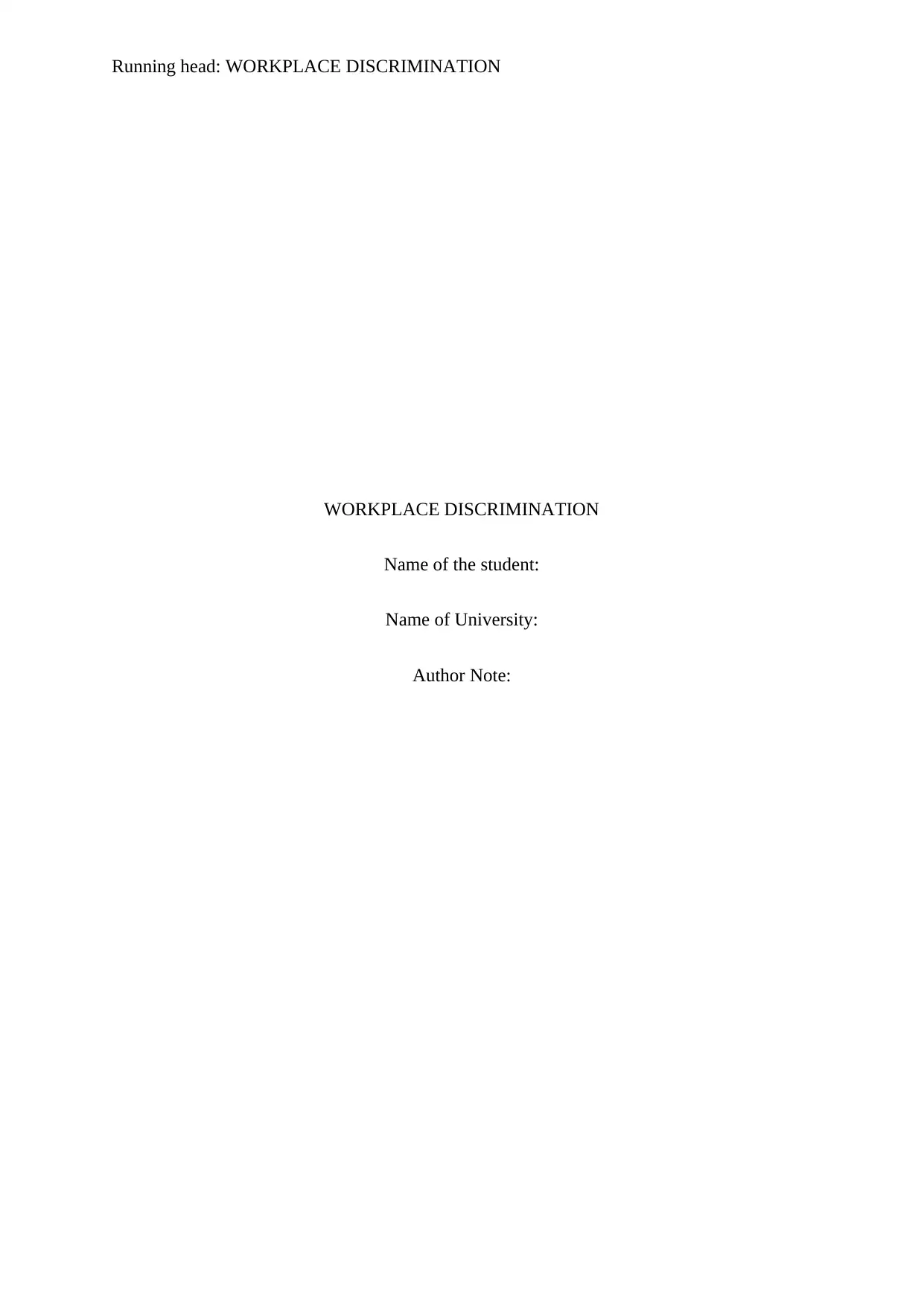
Running head: WORKPLACE DISCRIMINATION
WORKPLACE DISCRIMINATION
Name of the student:
Name of University:
Author Note:
WORKPLACE DISCRIMINATION
Name of the student:
Name of University:
Author Note:
Paraphrase This Document
Need a fresh take? Get an instant paraphrase of this document with our AI Paraphraser
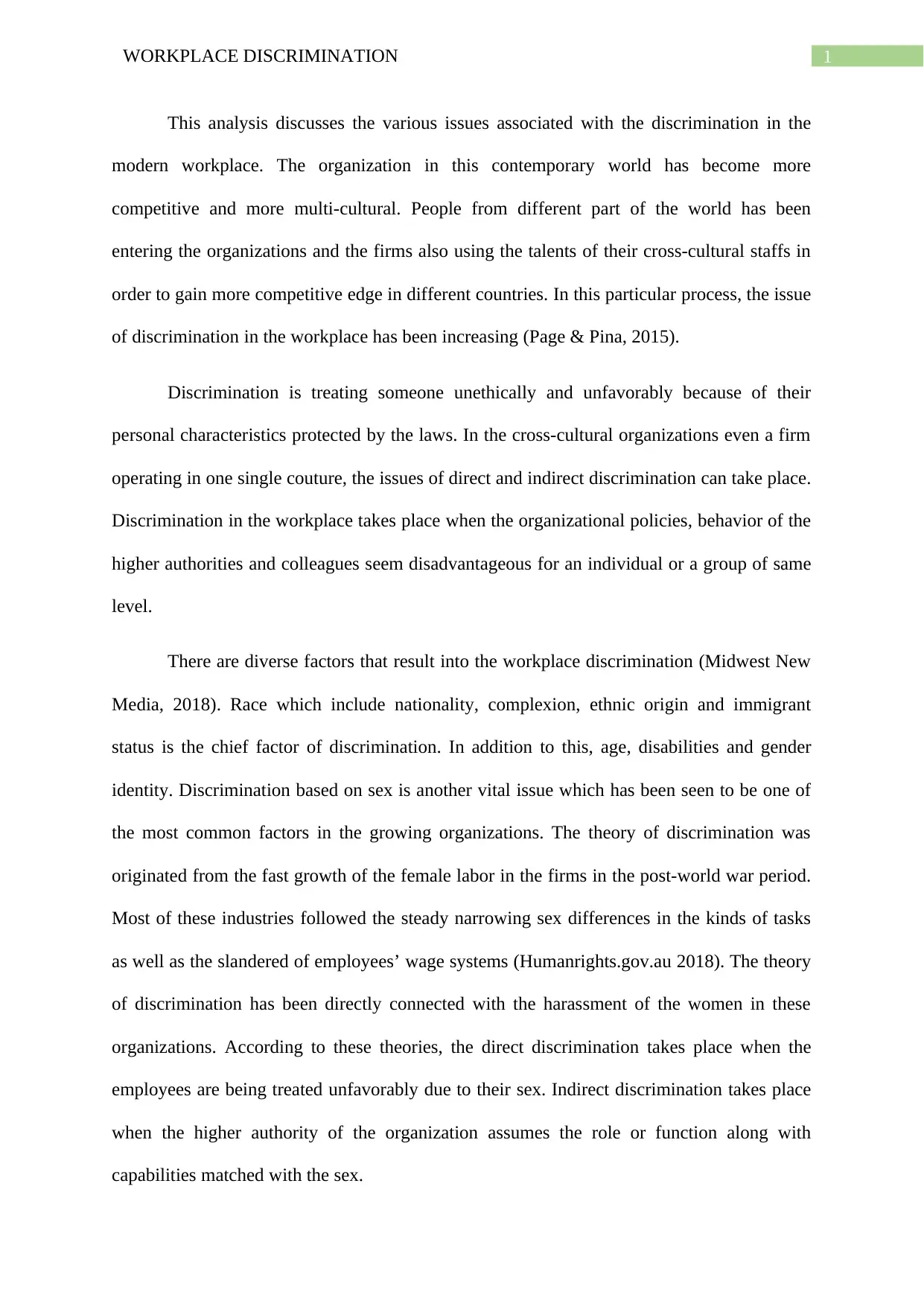
1WORKPLACE DISCRIMINATION
This analysis discusses the various issues associated with the discrimination in the
modern workplace. The organization in this contemporary world has become more
competitive and more multi-cultural. People from different part of the world has been
entering the organizations and the firms also using the talents of their cross-cultural staffs in
order to gain more competitive edge in different countries. In this particular process, the issue
of discrimination in the workplace has been increasing (Page & Pina, 2015).
Discrimination is treating someone unethically and unfavorably because of their
personal characteristics protected by the laws. In the cross-cultural organizations even a firm
operating in one single couture, the issues of direct and indirect discrimination can take place.
Discrimination in the workplace takes place when the organizational policies, behavior of the
higher authorities and colleagues seem disadvantageous for an individual or a group of same
level.
There are diverse factors that result into the workplace discrimination (Midwest New
Media, 2018). Race which include nationality, complexion, ethnic origin and immigrant
status is the chief factor of discrimination. In addition to this, age, disabilities and gender
identity. Discrimination based on sex is another vital issue which has been seen to be one of
the most common factors in the growing organizations. The theory of discrimination was
originated from the fast growth of the female labor in the firms in the post-world war period.
Most of these industries followed the steady narrowing sex differences in the kinds of tasks
as well as the slandered of employees’ wage systems (Humanrights.gov.au 2018). The theory
of discrimination has been directly connected with the harassment of the women in these
organizations. According to these theories, the direct discrimination takes place when the
employees are being treated unfavorably due to their sex. Indirect discrimination takes place
when the higher authority of the organization assumes the role or function along with
capabilities matched with the sex.
This analysis discusses the various issues associated with the discrimination in the
modern workplace. The organization in this contemporary world has become more
competitive and more multi-cultural. People from different part of the world has been
entering the organizations and the firms also using the talents of their cross-cultural staffs in
order to gain more competitive edge in different countries. In this particular process, the issue
of discrimination in the workplace has been increasing (Page & Pina, 2015).
Discrimination is treating someone unethically and unfavorably because of their
personal characteristics protected by the laws. In the cross-cultural organizations even a firm
operating in one single couture, the issues of direct and indirect discrimination can take place.
Discrimination in the workplace takes place when the organizational policies, behavior of the
higher authorities and colleagues seem disadvantageous for an individual or a group of same
level.
There are diverse factors that result into the workplace discrimination (Midwest New
Media, 2018). Race which include nationality, complexion, ethnic origin and immigrant
status is the chief factor of discrimination. In addition to this, age, disabilities and gender
identity. Discrimination based on sex is another vital issue which has been seen to be one of
the most common factors in the growing organizations. The theory of discrimination was
originated from the fast growth of the female labor in the firms in the post-world war period.
Most of these industries followed the steady narrowing sex differences in the kinds of tasks
as well as the slandered of employees’ wage systems (Humanrights.gov.au 2018). The theory
of discrimination has been directly connected with the harassment of the women in these
organizations. According to these theories, the direct discrimination takes place when the
employees are being treated unfavorably due to their sex. Indirect discrimination takes place
when the higher authority of the organization assumes the role or function along with
capabilities matched with the sex.
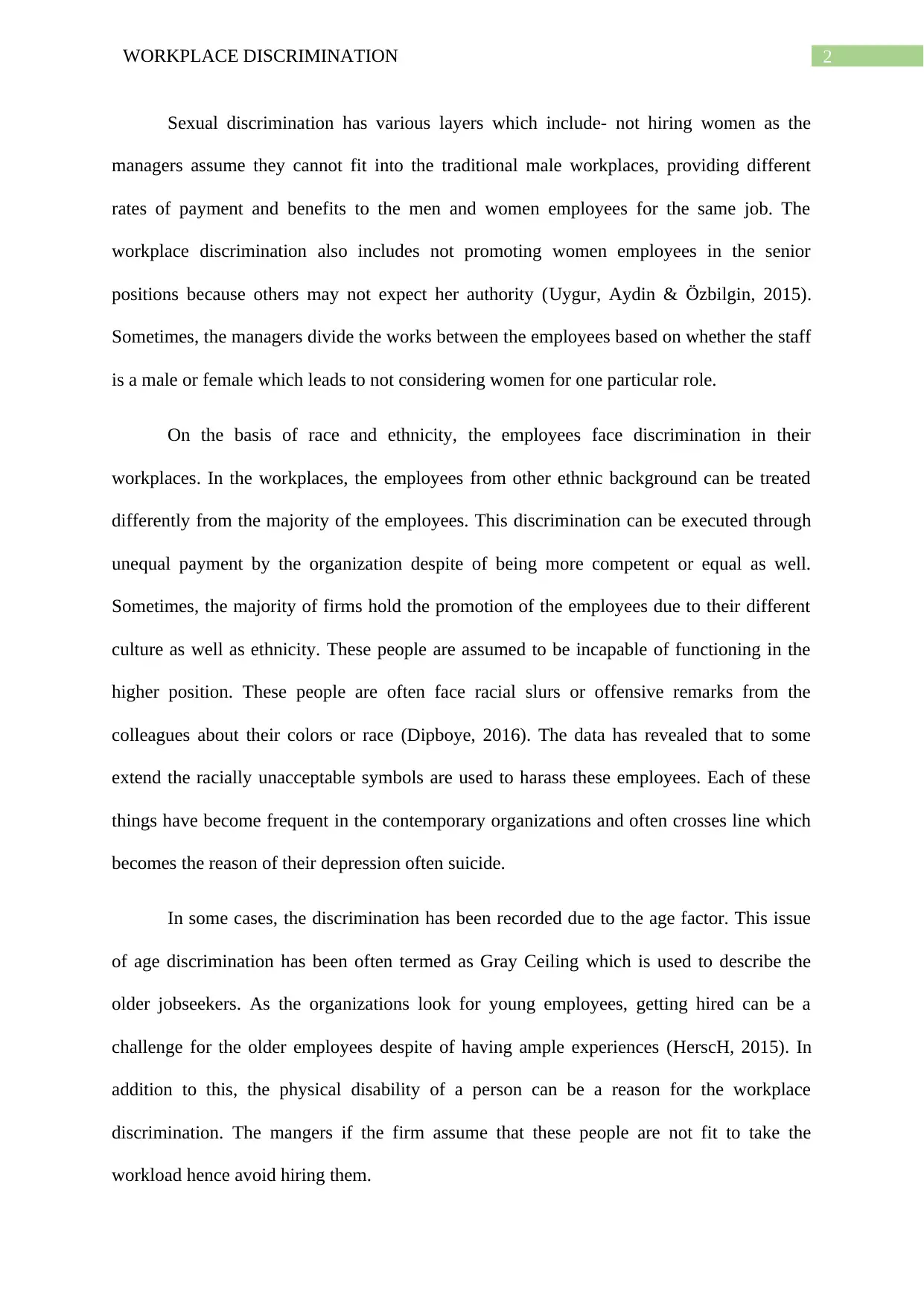
2WORKPLACE DISCRIMINATION
Sexual discrimination has various layers which include- not hiring women as the
managers assume they cannot fit into the traditional male workplaces, providing different
rates of payment and benefits to the men and women employees for the same job. The
workplace discrimination also includes not promoting women employees in the senior
positions because others may not expect her authority (Uygur, Aydin & Özbilgin, 2015).
Sometimes, the managers divide the works between the employees based on whether the staff
is a male or female which leads to not considering women for one particular role.
On the basis of race and ethnicity, the employees face discrimination in their
workplaces. In the workplaces, the employees from other ethnic background can be treated
differently from the majority of the employees. This discrimination can be executed through
unequal payment by the organization despite of being more competent or equal as well.
Sometimes, the majority of firms hold the promotion of the employees due to their different
culture as well as ethnicity. These people are assumed to be incapable of functioning in the
higher position. These people are often face racial slurs or offensive remarks from the
colleagues about their colors or race (Dipboye, 2016). The data has revealed that to some
extend the racially unacceptable symbols are used to harass these employees. Each of these
things have become frequent in the contemporary organizations and often crosses line which
becomes the reason of their depression often suicide.
In some cases, the discrimination has been recorded due to the age factor. This issue
of age discrimination has been often termed as Gray Ceiling which is used to describe the
older jobseekers. As the organizations look for young employees, getting hired can be a
challenge for the older employees despite of having ample experiences (HerscH, 2015). In
addition to this, the physical disability of a person can be a reason for the workplace
discrimination. The mangers if the firm assume that these people are not fit to take the
workload hence avoid hiring them.
Sexual discrimination has various layers which include- not hiring women as the
managers assume they cannot fit into the traditional male workplaces, providing different
rates of payment and benefits to the men and women employees for the same job. The
workplace discrimination also includes not promoting women employees in the senior
positions because others may not expect her authority (Uygur, Aydin & Özbilgin, 2015).
Sometimes, the managers divide the works between the employees based on whether the staff
is a male or female which leads to not considering women for one particular role.
On the basis of race and ethnicity, the employees face discrimination in their
workplaces. In the workplaces, the employees from other ethnic background can be treated
differently from the majority of the employees. This discrimination can be executed through
unequal payment by the organization despite of being more competent or equal as well.
Sometimes, the majority of firms hold the promotion of the employees due to their different
culture as well as ethnicity. These people are assumed to be incapable of functioning in the
higher position. These people are often face racial slurs or offensive remarks from the
colleagues about their colors or race (Dipboye, 2016). The data has revealed that to some
extend the racially unacceptable symbols are used to harass these employees. Each of these
things have become frequent in the contemporary organizations and often crosses line which
becomes the reason of their depression often suicide.
In some cases, the discrimination has been recorded due to the age factor. This issue
of age discrimination has been often termed as Gray Ceiling which is used to describe the
older jobseekers. As the organizations look for young employees, getting hired can be a
challenge for the older employees despite of having ample experiences (HerscH, 2015). In
addition to this, the physical disability of a person can be a reason for the workplace
discrimination. The mangers if the firm assume that these people are not fit to take the
workload hence avoid hiring them.
⊘ This is a preview!⊘
Do you want full access?
Subscribe today to unlock all pages.

Trusted by 1+ million students worldwide
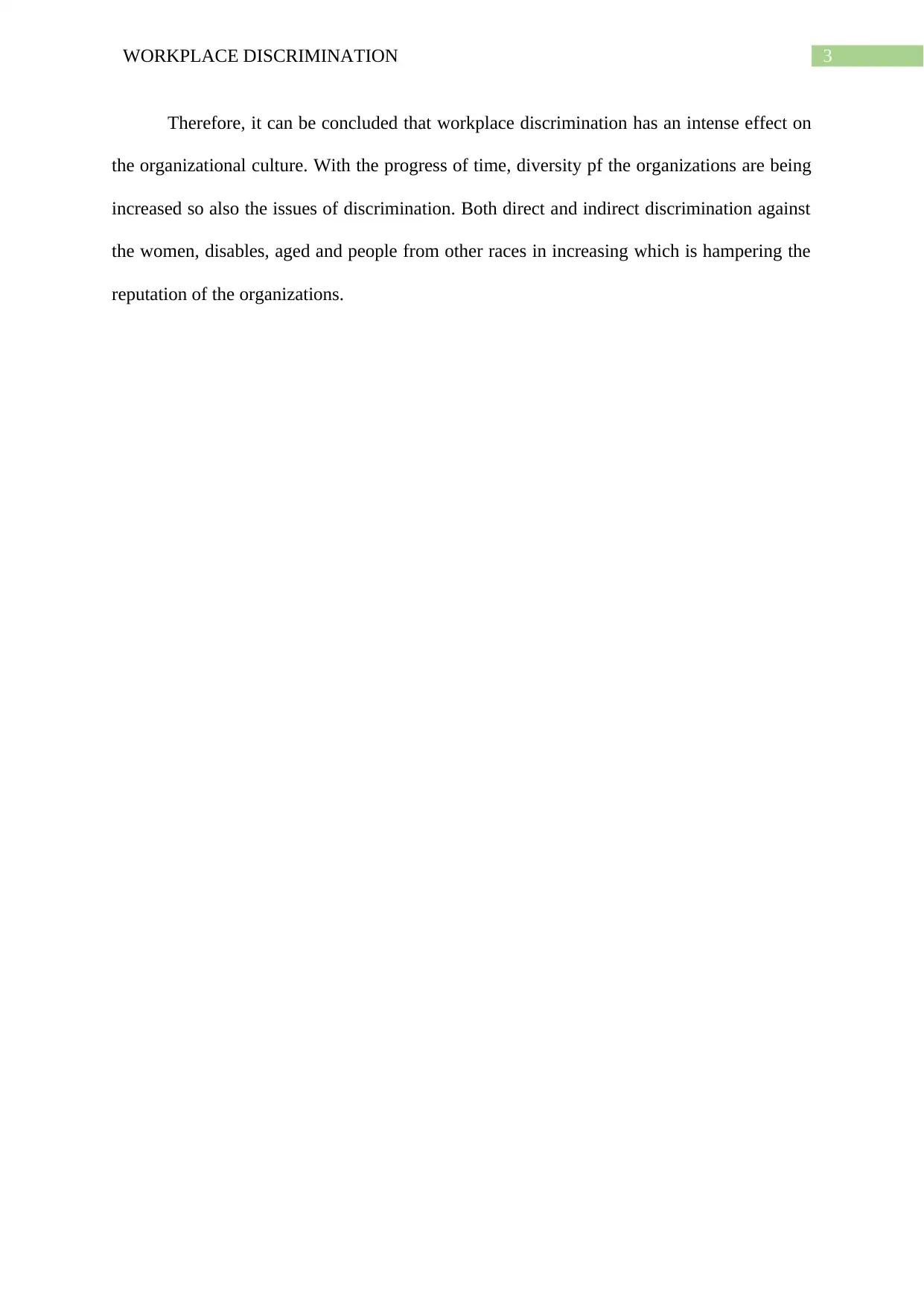
3WORKPLACE DISCRIMINATION
Therefore, it can be concluded that workplace discrimination has an intense effect on
the organizational culture. With the progress of time, diversity pf the organizations are being
increased so also the issues of discrimination. Both direct and indirect discrimination against
the women, disables, aged and people from other races in increasing which is hampering the
reputation of the organizations.
Therefore, it can be concluded that workplace discrimination has an intense effect on
the organizational culture. With the progress of time, diversity pf the organizations are being
increased so also the issues of discrimination. Both direct and indirect discrimination against
the women, disables, aged and people from other races in increasing which is hampering the
reputation of the organizations.
Paraphrase This Document
Need a fresh take? Get an instant paraphrase of this document with our AI Paraphraser
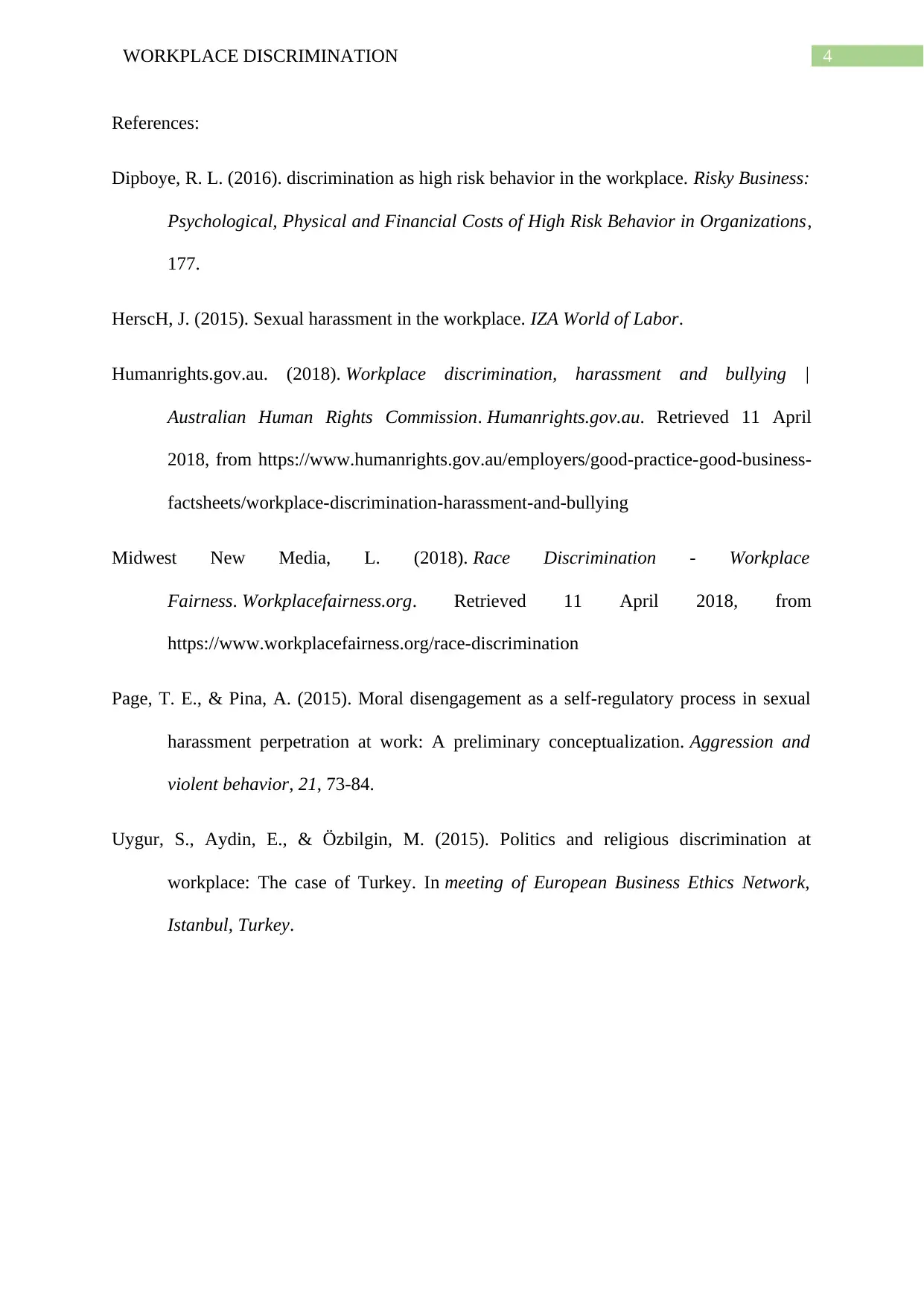
4WORKPLACE DISCRIMINATION
References:
Dipboye, R. L. (2016). discrimination as high risk behavior in the workplace. Risky Business:
Psychological, Physical and Financial Costs of High Risk Behavior in Organizations,
177.
HerscH, J. (2015). Sexual harassment in the workplace. IZA World of Labor.
Humanrights.gov.au. (2018). Workplace discrimination, harassment and bullying |
Australian Human Rights Commission. Humanrights.gov.au. Retrieved 11 April
2018, from https://www.humanrights.gov.au/employers/good-practice-good-business-
factsheets/workplace-discrimination-harassment-and-bullying
Midwest New Media, L. (2018). Race Discrimination - Workplace
Fairness. Workplacefairness.org. Retrieved 11 April 2018, from
https://www.workplacefairness.org/race-discrimination
Page, T. E., & Pina, A. (2015). Moral disengagement as a self-regulatory process in sexual
harassment perpetration at work: A preliminary conceptualization. Aggression and
violent behavior, 21, 73-84.
Uygur, S., Aydin, E., & Özbilgin, M. (2015). Politics and religious discrimination at
workplace: The case of Turkey. In meeting of European Business Ethics Network,
Istanbul, Turkey.
References:
Dipboye, R. L. (2016). discrimination as high risk behavior in the workplace. Risky Business:
Psychological, Physical and Financial Costs of High Risk Behavior in Organizations,
177.
HerscH, J. (2015). Sexual harassment in the workplace. IZA World of Labor.
Humanrights.gov.au. (2018). Workplace discrimination, harassment and bullying |
Australian Human Rights Commission. Humanrights.gov.au. Retrieved 11 April
2018, from https://www.humanrights.gov.au/employers/good-practice-good-business-
factsheets/workplace-discrimination-harassment-and-bullying
Midwest New Media, L. (2018). Race Discrimination - Workplace
Fairness. Workplacefairness.org. Retrieved 11 April 2018, from
https://www.workplacefairness.org/race-discrimination
Page, T. E., & Pina, A. (2015). Moral disengagement as a self-regulatory process in sexual
harassment perpetration at work: A preliminary conceptualization. Aggression and
violent behavior, 21, 73-84.
Uygur, S., Aydin, E., & Özbilgin, M. (2015). Politics and religious discrimination at
workplace: The case of Turkey. In meeting of European Business Ethics Network,
Istanbul, Turkey.
1 out of 5
Related Documents
Your All-in-One AI-Powered Toolkit for Academic Success.
+13062052269
info@desklib.com
Available 24*7 on WhatsApp / Email
![[object Object]](/_next/static/media/star-bottom.7253800d.svg)
Unlock your academic potential
Copyright © 2020–2025 A2Z Services. All Rights Reserved. Developed and managed by ZUCOL.





